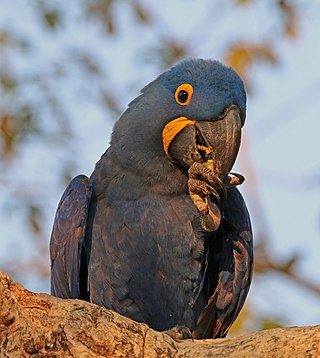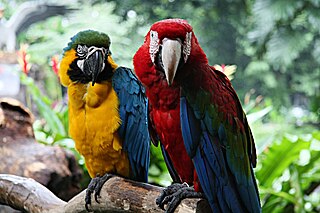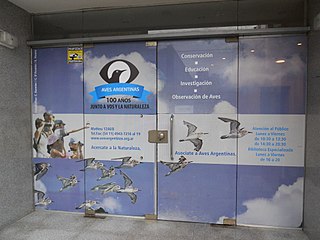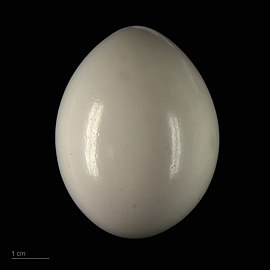
Macaws are a group of New World parrots that are long-tailed and often colorful, in the tribe Arini. They are popular in aviculture or as companion parrots, although there are conservation concerns about several species in the wild.

Spix's macaw, also known as the little blue macaw, is a macaw species that was endemic to Brazil. It is a member of tribe Arini in the subfamily Arinae, part of the family Psittacidae. It was first described by German naturalist Georg Marcgrave, when he was working in the State of Pernambuco, Brazil in 1638 and it is named for German naturalist Johann Baptist von Spix, who collected a specimen in 1819 on the bank of the Rio São Francisco in northeast Bahia in Brazil. This bird has been completely extirpated from its natural range, and following a several-year survey, the IUCN officially declared it extinct in the wild in 2019. However, after over 20 years of conservation efforts, 200 macaws have been bred from just two parent birds, and 52 individual birds have since been reintroduced into their natural environment in June 2022.

The scarlet macaw is a large yellow, red and blue Neotropical parrot native to humid evergreen forests of the Americas. Its range extends from southeastern Mexico to Peru, Ecuador, Colombia, Bolivia, Venezuela and Brazil in lowlands of 500 m (1,600 ft) up to 1,000 m (3,300 ft), the Caribbean island of Trinidad, as well as the Pacific island of Coiba. Formerly, the northern extent of its range included southern Tamaulipas. In some areas, it has suffered local extinction because of habitat destruction, or capture for the parrot trade, but in other areas, it remains fairly common. It is the national bird of Honduras. Like its relative the blue-and-yellow macaw, the scarlet macaw is a popular bird in aviculture as a result of its striking plumage.

The blue-and-yellow macaw, also known as the blue-and-gold macaw, is a large Neotropical parrot with a mostly blue dorsum, light yellow/orange venter, and gradient hues of green on top of its head. It is a member of the large group of neotropical parrots known as macaws. It inhabits forest, woodland and savannah of tropical Central and South America, as well as the island of Trinidad in the Caribbean. They are popular in aviculture because of their striking color, ability to talk, ready availability in the marketplace, and close bonding to humans.

The hyacinth macaw, or hyacinthine macaw, is a parrot native to central and eastern South America. With a length of about one meter it is longer than any other species of parrot. It is the largest macaw and the largest flying parrot species; the flightless kākāpō of New Zealand outweighs it at up to 3.5 kg. While generally easily recognized, it could be confused with the smaller Lear's macaw. Habitat loss and the trapping of wild birds for the pet trade have taken a heavy toll on their population in the wild, so the species is classified as Vulnerable on the International Union for Conservation of Nature's Red List, and it is protected by its listing on Appendix I of the Convention on International Trade in Endangered Species of Wild Fauna and Flora (CITES).

The blue-throated macaw, also known as the Caninde macaw or Wagler's macaw, is a macaw endemic to a small area of north-central Bolivia, known as Los Llanos de Moxos. In 2014 this species was designated by law as a natural patrimony of Bolivia. Until 2010, it was hunted by native people to make feathered "Moxeño" headdresses for "machetero" ritual dances.

The red-fronted macaw is a parrot endemic to a small semi-desert mountainous area of Bolivia. It is a critically endangered species; it has been successfully bred in captivity, and is available, if not common, as a pet. It is also sometimes known in the literature as Lafresnaye's macaw, named for the French ornithologist Frédéric de Lafresnaye, who was one of the first to describe the species.

The red-bellied macaw, also known as Guacamaya Manilata, is a medium-sized, mostly green parrot, a member of a group of large Neotropical parrots known as macaws. It is the largest of what are commonly called "mini-macaws". The belly has a large maroon patch which gives the species its name.

The military macaw is a medium- to larger-sized macaw, named after its green and red plumage vaguely resembling a military uniform. It is native from west-central México south through northern Argentina and Bolivia. While most wild populations are currently listed by the IUCN as vulnerable—and listed as endangered by México—, the species is still seen commonly in zoos and parks worldwide. The military macaw may be bred in captivity with relative ease, and is usually available through the pet trade. It is among the longest-lived and most expensive bird species one can own, requiring advanced knowledge, experience and confidence to keep them healthy, stimulated and thriving.

The red-shouldered macaw (Diopsittaca nobilis) is a small green South American parrot, a member of a large group of Neotropical parrots called macaws. The species is named for the red coverts on its wings. It is the smallest macaw, being 30–35 cm (12–14 in) in length - similar in size to the Aratinga parakeets. It is native to the tropical lowlands, savannah, and swamplands of Brazil, the Guianas, Bolivia, Venezuela, and far south-eastern Peru. There are three subspecies: The noble macaw(Diopsittaca nobilis cumanensis), Hahn's macaw(Diopsittaca nobilis nobilis), and the long-winged macaw(Diopsittaca nobilis longipennis). The long-winged macaw is a poorly distinct third subspecies that has longer wings, but is otherwise similar to the noble macaw. The Hahn's subspecies is named for German zoologist Carl-Wilhelm Hahn, who in 1834 began compiling Ornithologischer Atlas oder naturgetreue Abbildung und Beschreibung der aussereuropäischen Vögel (Engl: Ornithological Atlas or natural depiction and description of birds from outside Europe).

The great green macaw, also known as Buffon's macaw or the great military macaw, is a critically endangered Central and South America parrot found in Nicaragua, Honduras, Costa Rica, Panama, Colombia and Ecuador. Two allopatric subspecies are recognized; the nominate subspecies, Ara ambiguus ssp. ambiguus, occurs from Honduras to Colombia, while Ara ambiguus ssp. guayaquilensis appears to be endemic to remnants of dry forests on the southern Pacific coast of Ecuador. The nominate subspecies lives in the canopy of wet tropical forests and in Costa Rica is usually associated with the almendro tree, Dipteryx oleifera.

Ara is a Neotropical genus of macaws with eight extant species and at least two extinct species. The genus name was coined by French naturalist Bernard Germain de Lacépède in 1799. It gives its name to and is part of the Arini, or tribe of Neotropical parrots. The genus name Ara is derived from the Tupi word ará, an onomatopoeia of the sound a macaw makes.

The Cuban macaw or Cuban red macaw is an extinct species of macaw native to the main island of Cuba and the nearby Isla de la Juventud. It became extinct in the late 19th century. Its relationship with other macaws in its genus was long uncertain, but it was thought to have been closely related to the scarlet macaw, which has some similarities in appearance. It may also have been closely related, or identical, to the hypothetical Jamaican red macaw. A 2018 DNA study found that it was the sister species of two red and two green species of extant macaws.

The blue-winged macaw, in aviculture more commonly known as Illiger's macaw, is a species of small macaw found in central and eastern South America. The second name is in honor of the German ornithologist Johann Karl Wilhelm Illiger. It was previously placed in the genera Ara or Propyrrhura. Blue-winged macaws have been known to reach an age of 50–60 years.

The blue-headed macaw or Coulon's macaw is a macaw native to eastern Peru, northwestern Bolivia, and far western Brazil. It has a total length of about 41 cm (16 in), making it a member of the group of smaller macaws sometimes known as the mini-macaws, which includes any species of macaw with a total length of 50 cm (20 in) or less. As in all macaws, its tail is long and pointed and the bill is large and heavy.

The Lesser Antillean macaw or Guadeloupe macaw is a hypothetical extinct species of macaw that is thought to have been endemic to the Lesser Antillean island region of Guadeloupe. In spite of the absence of conserved specimens, many details about the Lesser Antillean macaw are known from several contemporary accounts, and the bird is the subject of some illustrations. Austin Hobart Clark described the species on the basis of these accounts in 1905. Due to the lack of physical remains, and the possibility that sightings were of macaws from the South American mainland, doubts have been raised about the existence of this species. A phalanx bone from the island of Marie-Galante confirmed the existence of a similar-sized macaw inhabiting the region prior to the arrival of humans and was correlated with the Lesser Antillean macaw in 2015. Later that year, historical sources distinguishing between the red macaws of Guadeloupe and the scarlet macaw of the mainland were identified, further supporting its validity.

Aves Argentinas / Asociación Ornitológica del Plata, is an Argentine non-profit environmental organization dedicated to conservation and birdwatching. Created in 1916, it is the oldest environmental organization in South America.

The Iberá Provincial Reserve is a provincial protected area in the north-west of Corrientes Province, north-eastern Argentina. Established on 15 April 1983, it contains a mix of swamps, bogs, stagnant lakes, lagoons, natural sloughs and courses of water. With an area of about 1,300,000 ha, the reserve spans a significant 14% of the Corrientes province, and is the largest protected area in the country.

The Catalina macaw, sometimes known as the rainbow macaw is a first generation hybrid between the blue-and-gold macaw and scarlet macaw. As catalina macaws are hybrids, they do not have a true scientific name. The best way to represent these birds in taxonomy is by the expression Ara ararauna × Ara macao.

Hybrid macaws are the product of cross breeding of more than one species of macaw, resulting in a hybrid. They are often characterized and bred for their unique and distinct coloring, and for this reason, are highly sought after and valued in the exotic pet trade. Macaws are native to tropical North and South America. Hybridization of macaws occurs both in nature and captivity, being one of the few species that can produce viable, fertile offspring unlike many other hybrids produced from crossing different species resulting in sterile hybrids with factors that limit their success of survival. Hybrid macaws do not hold any scientific names, and are often labeled by the two macaw species they are produced from

























